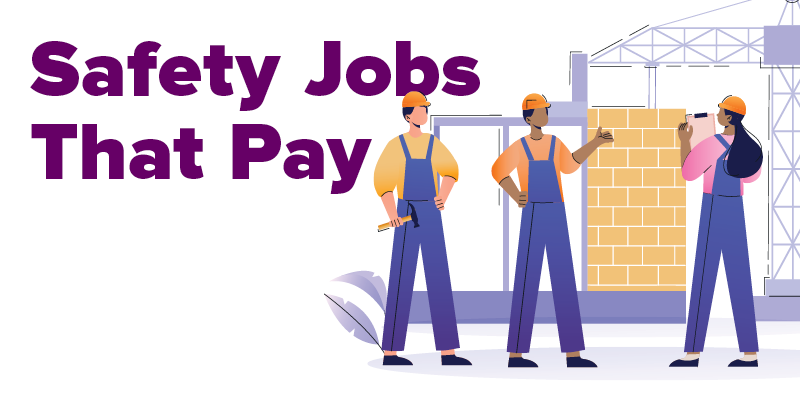
Keeping people safe is an important job. Did you know there are many growing careers that focus on protecting workers and the general public? People in these occupations combine technical knowledge with an understanding of safety regulations to inspect, monitor and respond in a variety of settings.
Here are 10 safety-related occupations all pay at least the median annual wage – and six require less than a bachelor’s degree.
Agricultural inspectors
What they do: Agricultural inspectors examine agricultural products, processing equipment and facilities, and fish and logging operations to make sure they comply with the laws around safety and quality.
2020 median pay: $46,700
Typical entry-level education: Bachelor’s degree
Number of jobs (2019): 15,200
Projected growth, 2019-29: 2% (slower than average)
Occupational openings, 2019-29 annual average: 2,200
Construction and building inspectors
What they do: Construction and building inspectors ensure buildings and infrastructure – such as bridges, highways and water systems – comply with safety regulations. They also inspect electrical, heating and plumbing systems.
2020 median pay: $62,860
Typical entry-level education: High school diploma or equivalent
Number of jobs (2019): 120,800
Projected growth, 2019-29: 3% (as fast as average)
Occupational openings, 2019-29 annual average: 13,500
Emergency management directors
What they do: Emergency management directors prepare plans and procedures for responding to natural disasters and other emergencies. They also help lead the response during and after emergencies, often in coordination with public safety officials, elected officials, nonprofit organizations and government agencies.
2020 median pay: $76,250
Typical entry-level education: Bachelor’s degree
Number of jobs (2019): 10,400
Projected growth, 2019-29: 4% (as fast as average)
Occupational openings, 2019-29 annual average: 700
Fire inspectors and investigators
What they do: Fire inspectors examine buildings in order to detect fire hazards and ensure that federal, state and local fire codes are met. Fire investigators determine the origin and cause of fires and explosions.
2020 median pay: $64,610
Typical entry-level education: Postsecondary nondegree award
Number of jobs (2019): 14,200
Projected growth, 2019-29: 6% (faster than average)
Occupational openings, 2019-29 annual average: 1,500
Forest fire inspectors and prevention specialists
What they do: Forest fire inspectors and prevention specialists assess outdoor fire hazards in public and residential areas. They look for fire code infractions and for conditions that pose a wildfire risk. They also recommend ways to reduce fire hazards. During patrols, they enforce fire regulations and report fire conditions to their central command center.
2020 median pay: $42,150
Typical entry-level education: High school diploma or equivalent
Number of jobs (2019): 2,300
Projected growth, 2019-29: 24% (much faster than average)
Occupational openings, 2019-29 annual average: 300
Health and safety engineers
What they do: Health and safety engineers develop procedures and design systems to protect people from illness and injury, and property from damage. They combine knowledge of engineering and of health and safety to make sure that chemicals, machinery, software, furniture and other products will not cause harm.
2020 median pay: $94,240
Typical entry-level education: Bachelor’s degree
Number of jobs (2019): 26,400
Projected growth, 2019-29: 4% (as fast as average)
Occupational openings, 2019-29 annual average: 1,700
Occupational health and safety specialists
What they do: Occupational health and safety specialists inspect workplaces safety, health and environmental issues. They also help design procedures to protect workers from hazards.
2020 median pay: $76,340
Typical entry-level education: Bachelor’s degree
Number of jobs (2019): 100,500
Projected growth, 2019-29: 4% (as fast as average)
Occupational openings, 2019-29 annual average: 5,500
Occupational health and safety technicians
What they do: Occupational health and safety technicians conduct tests and measure hazards to help prevent harm to workers, property, the environment and the general public.
2020 median pay: $53,340
Typical entry-level education: High school diploma or equivalent
Number of jobs (2019): 22,100
Projected growth, 2019-29: 5% (faster than average)
Occupational openings, 2019-29 annual average: 1,200
Public safety telecommunicators
What they do: Public safety telecommunicators, usually known as police, fire, and ambulance dispatchers, answer emergency and nonemergency calls from people who need help. They also monitor the status of first-responder agencies.
2020 median pay: $43,290
Typical entry-level education: High school diploma or equivalent
Number of jobs (2019): 98,300
Projected growth, 2019-29: 6% (faster than average)
Occupational openings, 2019-29 annual average: 9,200
Transportation inspectors
What they do: Transportation inspectors examine and monitor equipment, systems or goods in connection with the safe movement of cargo or people.
2020 median pay: $78,400
Typical entry-level education: High school diploma or equivalent
Number of jobs (2019): 30,200
Projected growth, 2019-29: 2% (slower than average)
Occupational openings, 2019-29 annual average: 2,900
You can explore these and hundreds of other occupations in the BLS Occupational Outlook Handbook. And you can find career exploration and assessment tools in the Department of Labor’s O*Net Resource Center.
Cal Hockemeyer and Patricia Tate are economists in the U.S. Bureau of Labor Statistics. Follow BLS on Twitter at @BLS_gov.

 U.S. Department of Labor Blog
U.S. Department of Labor Blog
